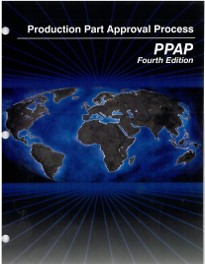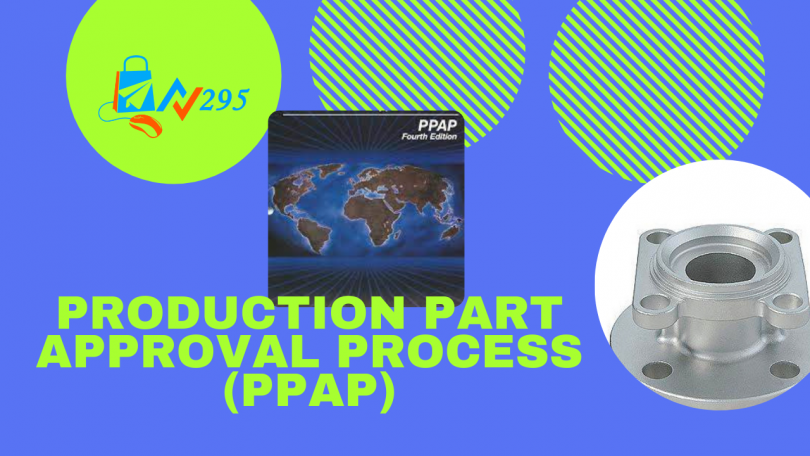The Production Part Approval Process (PPAP) is useful for gaining trust in component suppliers and their manufacturing processes. Controlling costs and maintaining a high level of quality have become critical to a company’s success in today’s competitive manufacturing market. Outsourced parts have increased due to rising equipment, material, and labor prices, as well as expanding global markets.
Many pieces are outsourced to companies in other countries. Longer lead times and bigger order quantities are frequently the outcomes of this. As a result, it’s become critical to delivering high-quality parts that satisfy the customer’s needs the first time and every time. The automobile and aerospace sectors were the first to use PPAP.

PPAP is being used by a variety of businesses to increase communication and provide high-quality products. The guidebook issued by the Automobile Industry Action Group is the ultimate resource for PPAP knowledge within the automotive industry (AIAG).
What is the Production Part Approval Process (PPAP)
The approval process for new or revised parts, as well as parts produced using new or significantly revised production methods, is defined by the PPAP. The PPAP process has 18 steps that must be completed before production-level parts may be approved. For each submission, not all of the elements are required.
Five PPAP submission levels are widely accepted.
The PPAP manual offers thorough information, rules, and sample documents that can be used to fulfill the process’s needs. The PPAP submission that results proves that the supplier met or surpassed the customer’s requirements and that the process can consistently produce high-quality products.
Why is it necessary to go through the approval process for production parts? (PPAP)
The PPAP process confirms that the supplier understands the client engineering design criteria and needs, as well as that the process is capable of consistently producing goods that meet those requirements during a real production run at the quoted rate.
PPAP and other quality tools are being incorporated into more industries, thus it’s critical to grasp the PPAP criteria if you want to stay competitive as a parts supplier.
When Should Production Part Approval Be Performed? (PPAP)
Any new part submission and any change to an existing component or process require a PPAP approval. A PPAP can be requested by the customer at any time during the product’s life cycle. This necessitates that the supplier maintains a quality system that develops and documents all PPAP submission criteria at all times.
How to Carry Out the Approval Process for Production Parts (PPAP)
Completing a PPAP submission is a time-consuming process. This thorough procedure consists of several critical parts that must be performed to ensure that the manufacturing process will result in a high-quality product. A PPAP submission does not always require all of the requirements. During the quoting process, the PPAP’s specific needs are frequently negotiated.
PPAP Submission Levels
The PPAP submission requirements are usually divided into five levels or classifications:
- Level 1 – Part Submission Warrant (PSW) only submitted to the customer
- Level 2 – PSW with product samples and limited supporting data
- Level 3 – PSW with product samples and complete supporting data
- Level 4 – PSW and other requirements as defined by the customer
- Level 5 – PSW with product samples and all supporting data to be retained at the supplier’s manufacturing facility for review
What are Important PPAP Components?
The following is a list of all 18 elements, along with a brief description of each:
1.Design Documentation
Design documentation must include a copy of both the customer’s and supplier’s drawings. A copy of the purchase order should also be included in the documentation. In some circumstances, the provider is required to provide material composition documentation.
The purchase order is used to ensure that the correct part is ordered and that the revision level is correct.
The design engineer must ensure that the two drawings are identical and that all key attributes have been determined.
Material composition data is necessary to demonstrate that the material used to make the parts fit the customer’s specific specifications.
2.Engineering Change Documentation
If the PPAP is necessary as a result of a request for a part or product modification, the paperwork requesting and approving the change must be included in the PPAP package. A copy of the Engineering Change Notice (ECN), which must be approved by the customer engineering department, is normally included in this documentation.
3.Customer Engineering Approval
When the PPAP requires it, the supplier must show proof of customer engineering department approval.
The customer may order pre-PPAP samples for onsite testing if necessary. The samples must be intended for production and must be shipped with a waiver allowing for testing. After the testing is completed, the test engineers will send a permission form for inclusion in the PPAP submission.
Note: Before submitting parts to the customer, a copy of a “Temporary Deviation” is usually necessary.
4.Design Failure Mode and Effects Analysis
- Design Failure Mode and Consequences Analysis (DFMEA) is a cross-functional exercise that investigates design risk by examining potential failure modes, their effects on the product or customer, and their likelihood of occurrence.
- Product problems are one of these failure modes.
- The product’s performance or lifespan has been shortened.
- Regulatory and safety concerns
- The DFMEA should be evaluated and updated throughout the product life cycle.
5.Process Flow Diagram (PFD)
The Process Flow Diagram graphically depicts the complete process of putting together the component or final assembly. Incoming material, assembly, testing, rework, and shipping are all part of the process flow.
6. Process Failure Mode and Effects Analysis (PFMEA)
A Process Failure Mode and Effects Analysis (PFMEA) examines all steps in the manufacturing process to identify and document any potential process quality risks. The PFMEA is a living document that should be maintained even after the product has been put into regular production.
7.Control Plan (CP)
The Control Plan is one of the PFMEA’s outputs. The Control Plan outlines all of the product’s Special Characteristics as well as the inspection procedures that must be used to ensure that products fulfill the customer’s quality expectations consistently.
8.Measurement System Analysis Studies
Gage Repeatability & Reproducibility (GR&R) studies on measurement equipment used during assembly or quality control checks will be included in Measurement System Analysis (MSA) studies. All gauges and measurement equipment must have calibration records.
9.Dimensional Reports
To ensure that the product fits the print criteria, a dimensional layout of sample parts is required. The samples should be chosen at random from a large production run of at least 30 pieces. Each dimension on the drawing is checked against the final assembly to ensure that it meets the requirements. The results are entered into a spreadsheet and submitted with the PPAP.
10.Material & Performance Tests Reports
Include a copy of the Design Verification Plan and Report in this element (DVP&R). Every validation test performed on the part is summarised in the DVP&R. It should include a list of all tests carried out, an explanation of how each test was carried out, and the results of each test.
Copies of all certification documents for all materials (steel, plastics, etc.) indicated on the prints may also be included in this area. The material certification must demonstrate conformity with the print’s specific call.
11.Initial Process Capability Studies
All production processes will undergo initial process studies, which will include Statistical Process Control (SPC) charts for the product’s important attributes. These investigations show that the critical processes are stable, exhibit normal fluctuation, and operate at or near their nominal values.
12.Qualified Laboratory Documentation
Qualified laboratory documentation comprises any lab’s industry certificates that participated in validation testing. This could be for an in-house test lab or any off-site contracted test labs utilized for validation or material certification testing.
13. Appearance Approval Report (AAR)
The Appearance Approval Report (AAR) is only for components that impact appearance. This report certifies that the customer has examined the final product and that it complies with all of the design’s required appearance standards. Information on color, texture and other aspects of appearance could be included in the requirements.
14.Sample Production Parts
After product development, sample production parts are normally provided to the customer for approval and stored at either the customer’s or supplier’s location. A photograph of the production pieces is frequently provided in the PPAP paperwork, as well as information about where the parts are housed.
15. Master Sample
A master sample is a final product sample that the customer inspects and signs off on. The master sample part is utilized to train operators and serves as a comparison point for regular production parts if any part quality issues develop.
16. Checking Aids
This is a comprehensive collection of production checking aids. All tools needed to examine, test, or measure items during the assembly process should be included. The list should include a description of the tool as well as the item’s calibration schedule. Check fixtures, contour, variable and attribute gauges, models, and templates are examples of checking aids.
MSA may be necessary for all checking aids, depending on the needs of the customer.
17. Specific Customer Requirements
Any particular client requirements should be included in this section of the submission package. Customer-specific requirements for bulk materials must be recorded on the “Bulk Material Requirements Checklist.”
18.Part Submission Warrant (PSW)
The Part Submission Warrant (PSW) form is a condensed version of the whole PPAP submission. Unless the customer specifies otherwise, each part number requires a PSW.
The PSW contains the following information:
- The purpose for submission (design change, annual re-validation, etc.)
- The level in which documents have been submitted
- There is a section for any required explanations or remarks.
- Signature of an authorized person from the supplier, as well as contact information
- An space allowing the customer to identify the PPAP’s disposition.
Conclusion
The PPAP procedure is complex and time-consuming. The PPAP package documents the supplier’s capacity to meet all client needs and contains documentation of different cross-functional tools. PPAP gives clients enough information to verify that all aspects of the design and manufacturing processes have been thoroughly examined, ensuring that only high-quality products are shipped to the final customer.
Related Articles:
3. Top 6 Method Of Purchasing Materials
Quality HUB India offered Online Courses on ‘Core Tools“
Hindi Version
- Advanced Product Quality Planning(APQP)+ Production Part Approval Process (PPAP)
- Statistical Process Control (SPC)
- Measurement System Analysis (MSA) +Statistical Process Control(SPC)
- Failure Mode & Effects Analysis (FMEA) -Latest Edition (AIAG+VDA)
- Complete Core Tool (APQP+PPAP+MSA+SPC+FMEA)
English Version
- Advanced Product Quality Planning(APQP)
- Production Part Approval Process (PPAP)
- Advanced Product Quality Planning(APQP)+ Production Part Approval Process (PPAP)
- Statistical Process Control (SPC)
- Measurement System Analysis (MSA)
- Failure Mode & Effects Analysis (FMEA) -Latest Edition (AIAG+VDA)
- Complete Core Tool (APQP+PPAP+MSA+SPC+FMEA)









[…] 4. What is the Production Part Approval Process (PPAP)? What are Important PPAP Components? […]
[…] Production Part Approval Process (PPAP) […]
[…] Production Part Approval Process (PPAP) […]
I found your article very informative. I have increased my subject clarity of PPAP. Thanks for such valuable information.